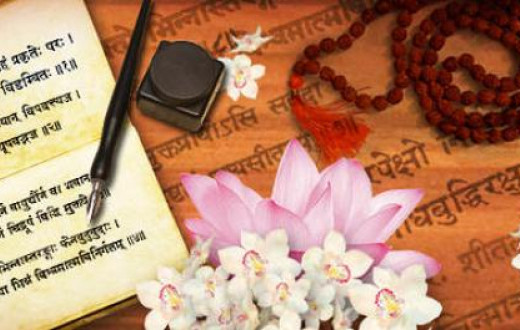Bridging Worlds through Knowledge
One often hears in the English language, the remark, “Behind every successful man is a woman”. This phrase conjures up an image of the woman being lesser than the male gender and playing only a supportive role, while the man is the achiever.
In stark contrast to the above statement and view, in India and the Indian languages, the wife is called “Saha Dharmini”, meaning one who is along with the man. This term implies that the wife and the husband are to go along in life together, performing their deeds together, towards leading a righteous life, pursuing the 4 goals of life namely, Dharma – which may be translated in a limited way, as righteousness, Artha - wealth, Kama – desires and pleasures and Moksha – liberation, salvation.
Many commonly understand "Saha” to mean equal. But there is a different word for equal, namely “Sama”, meaning the same level.
So the term “Saha Dharmini” must have a deeper connotation.
In many languages, brothers and sisters are called Sahodara and Sahodari respectively, meaning the ones who along with you, bear and share the joys and burdens of a joint family.
Saha seems to be more than just equal.
Saha denotes a form of partnership, “co-" as in cooperative, togetherness. And for a partnership, togetherness and a cooperative effort to be successful, it calls for a sense of complementing one another to complete the task on hand effectively. The word Saha therefore denotes complementary, helping.
If the two partners are equals and have equal of everything, there would definitely be times when their strengths would add up and double the gains. But there would also be times when both would be found lacking and there would be great gaps and falls.
Equals – leave gaps
While in the case of complementing, what one lacks, the other can provide, thus leaving no room for a gap in the collective unit.
Complementary Units – fit perfectly, no gaps
If every such, complete family unit were to complement each other in a collective living community, then there would be no gaps in the society, civilization as a whole too.

Amongst equals, each tries to score over the other. Equals lead to competition, infights and separation.
In a complement, since each one is aware of the strengths and weaknesses of each other, they do not see any competition from the other. So complements lead to dependency, togetherness and partnership.
This philosophy formed the basis for the framing of the various family models and the structure of the Indian society, in the days of the past.
By referring to a wife as a Saha Dharmini, Indian thought and ethos, thus stressed on the fact that men and women are complementary in nature to one another and can only collectively perform their righteous duties at 3 levels, namely for their,
1. home and family
2. society and community
3. culture and civilization
We can see such a complementing nature at work in the whole of Nature.
In lions, the symbol of masculinity, relents to this driving force of Nature. It is the females in a pride of lions, who typically hunt and bring back food for the pride. However, it is the male, the lion who gets to eat first and the most, before the others get their share. This is in return for his role of keeping the pride together and safe.
A representation of such a complementing concept is the depiction of Shiva, a popular divinity of the land as ArdhaNaari, meaning half woman, where the figure of half man and half woman sharing every part of the body shows the complementary nature of roles they are supposed to play in all activities of life.
Ardhanaari
This is further exemplified and elaborated in the concept of the three feminine divinities, the wives of the three primary divinities, Brahma, Vishnu and Shiva, in the Indian pantheon of Gods.
If we pause and observe intently,
- the wife of Brahma the creator, is Saraswathi, the embodiment of knowledge, in order to create, knowledge is a requisite and Saraswathi brings in this knowledge
- the wife of Vishnu, the preserver, is Lakshmi, the embodiment of wealth, in order to sustain and operate, wealth is a requisite and Lakshmi brings this wealth
- the wife of Shiva, the regenerator, recycler, is Shakthi, the embodiment of energy in order to recycle i.e. destroy and recreate, energy is a requisite and Shakthi brings in that energy.
The masculine aspect in these concepts, denote a function in the cycle of the Universe, while the feminine aspect denotes the substance or resource required for this functioning.
It is the understanding of this complementary nature of Nature, all the way from the divine forces at work throughout the Universe, to the various living forms in this Universe, including man and woman on earth, that formed the ethos of the land of India.
This ethos through the ages has given the due position and respect, in all spheres of life, to men and women.
It is this realization that was put in practice in various facets of life concerning men and women and their roles in society, in India, through the ages. To an extent, this ethos also found reflection in other fields also, namely Astronomy and social customs.
It is time for all of us in this world, to focus on Saha, the complementing factor too, rather than on Sama, the equalizing factor alone.
Understanding our ancient ways of living and picking a leaf or two of wisdom from them, can help us in understanding ourselves better and handling our relationships and business in harmony with each other and with nature.
Bharath Gyan is conceptualized by D. K. Hari and D. K. Hema Hari with the objective to scientifically collate and disseminate the knowledge of India and its ties with other civilizations from ancient to modern times









































































































